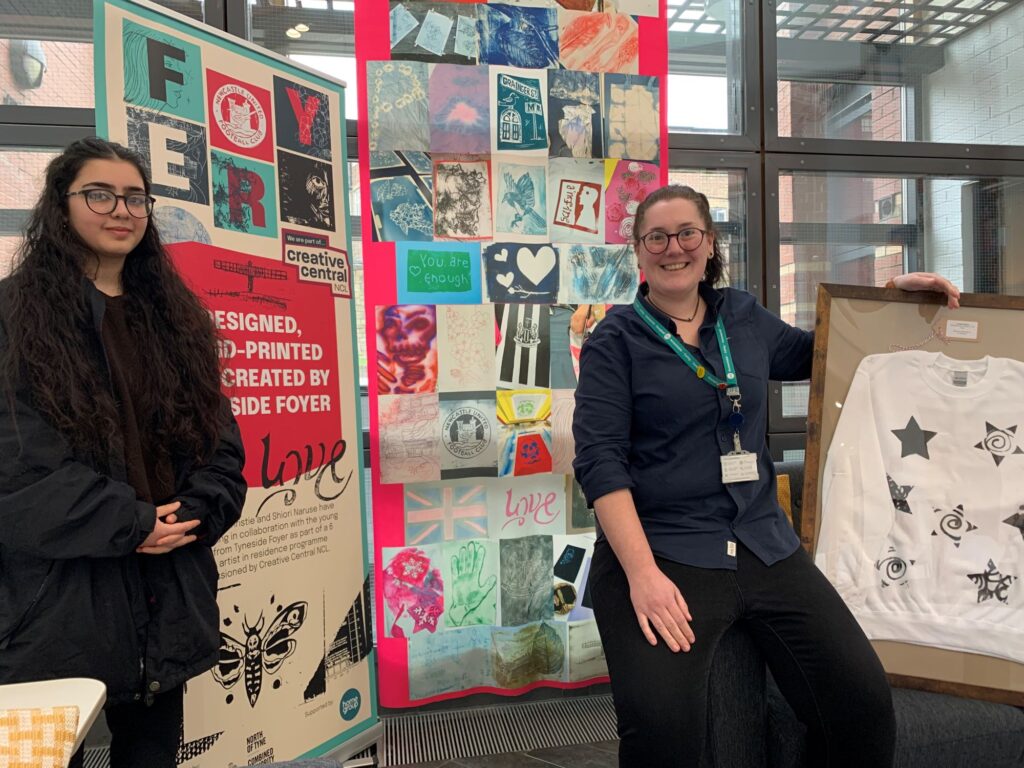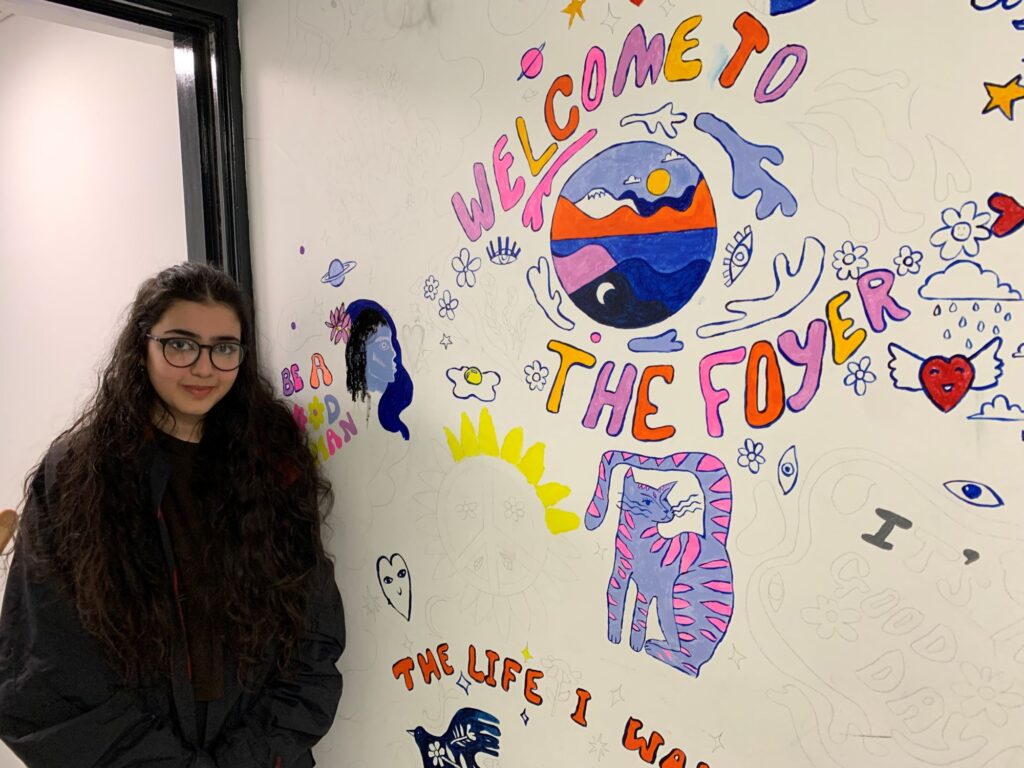
Easily the most enthusiastic speaker at the launch of Creative Central NCL, Newcastle’s new creative zone, was Jodie Robertson, not an artist or even employed in the cultural sector.
It wasn’t that there was a lack of enthusiasm in the room (Alphabetti Theatre, as so often, was buzzing).
But Jodie, client services manager at the Tyneside Foyer, spoke passionately of the transformative nature of one of the early projects which involved artists passing on skills to some of the young people who live in the building on Westgate Road.
The project finished but the benefits linger, as you’ll see in the reception area of the facility run by Home Group.
Eye-catching pictures decorate the otherwise bland walls and there’s a frieze of screenprints, each individual artwork seeming to draw power from others around.

Against one wall is a framed sweatshirt with printed stars. More than just a garment, it has become a symbol of achievement. And it looks good too.
“We’re really proud of what they’ve done,” says Jodie when I catch up with her at the Tyneside Foyer to see if the project had lasting effects.
“As you can see, we’ve still got everything up. The customers want this service to feel like they’ve had a part in it and so we have these legacy pieces around for them.”
The ‘customers’ are the young people who call this place home for a couple of years while sorting their lives out.
“At the Tyneside Foyer,” states the Home Group catalogue, “we provide supported accommodation for young homeless people (aged 16-24) with complex needs.”
Jodie, homeless herself for six years, speaks of them with compassion and understanding. No initiative involving them can be rushed into.
But she says the call out from Creative Central NCL appealed from the start.
“We knew art would have therapeutic value because our own occupational therapists do a lot of tactile work with customers and we’ve seen the benefits of that.

“But an outcome we really wanted was for them to feel a part of the community because you can be ostracised if people find you’re living here.
“It was really to make them feel they belong and I think we got that.”
Creative Central NCL is one of three creative zones established by the North of Tyne Combined Authority, in association with local councils, to help places fulfil their potential and generate opportunities.
The first contact for Jodie was Vikki Leaney and Alison Flanagan Wood, respectively Creative Central NCL project manager and arts development officer at Newcastle City Council.
Alison recalls how the Tyneside Foyer project began with finding what the young people wanted from the experience and then approaching artists who might be able to deliver it over six months.
In the end three pairs of creative practitioners were invited to pitch to the young people and printmakers Nick Christie and Shiori Naruse got the nod.
“Our young people like to do things with their hands,” says Jodie, “and some have barriers with regard to written and spoken communication.
“They went with the printing because it was interactive and the possibilities seemed endless.”
She tells me of the challenges faced by the people in her charge, including mental health issues and lack of familial support. With confidence often lacking, they can’t all easily be won over.

Nick and Shiori visited twice a week, with weekends and evenings sometimes included to catch as many potential participants as possible.
Some Tyneside Foyer customers have jobs or attend college, explains Jodie. Others lack a structured routine.
While a few attended most sessions, some would pop in and out.
There are customers with ADHD (attention deficit/hyperactivity disorder) and others nervous about venturing out. Some are refugees in a strange city.
“This really helped them leave their rooms and have something planned to look forward to,” says Jodie.
“Young people can be indecisive but this project has had so many social benefits. We’ve seen a reduction in self-harm among those who engaged with it and improved relations with support workers.
“Less self-harm and criminality means fewer police visits and trips to hospital. Our customers are well. That’s the end goal. It can be hard, even in here. I was homeless myself and so I know.”

The crowning achievement was the pop-up shop in the Grainger Market which the young people ran, selling items they had made and raising several hundred pounds to be reinvested in art activity.
“One came out of her shell to the point where she ended up taking the card payments in the Grainger Market,” says Jodie.
“It might sound like a small thing but she was painfully reclusive through anxiety. She was keen on art so able to sell quite a lot.”
Don’t judge young homeless people, she urges. Some have high aspirations.
One customer who agrees to meet is Anita who is 19, studying A levels in maths, biology and chemistry and hoping to study dentistry at Glasgow University.
“The staff were really kind and reminded us about the sessions by text,” she says. “Once I’d come to a few of them I really started to enjoy it.
“In the end I was coming without reminders. We learned different things such as screen printing and lino cutting.
“It gave me a lot of pride in my work and I felt appreciated and really rewarded. It was nice to have the support of the professionals and to see other people’s artwork.”

At the workshop in Cobalt Studios, which he shares with Shiori and fellow printmaker Alfons Bytautas, Nick Christie reflects fondly on the Tyneside Foyer project.
“We had to be understanding but Shiori and I are quite patient and easy going. We weren’t going to make them sit down if they didn’t want to.
“It was about making sure they were able to get involved.
“When we started talking about products, they saw the possibility of the market.
“It gave them something to work towards which seemed important, and being taken seriously.
“Not all of them are taken seriously but given structure they did come out of their shells and engage with the public which was really nice to see.”

Nick says he and Shiori, who teaches at the Northern School of Art in Hartlepool, began by demonstrating drypoint and moved on to other printmaking techniques such as linocut and screenprint.
When people started taking their creations to their rooms, the pair must have realised they were getting through.
It was the first time they had collaborated in this way and coincided with their acquisition of the workshop in the Ouseburn Valley.
Both were gratified to see the young people responding to their sessions.
“I enjoyed seeing the effect it had on them, the therapeutic part of the process which developed to the point where they could do things themselves and then teach other people,” recalls Nick.

The project ended with an exhibition at the Tyneside Foyer where this happened.
Originally from Bradford, Nick did a fine art degree at Northumbria University and got hooked on printmaking during a subsequent fellowship year.
After graduating he carried on printmaking while working part-time as a Gateshead postman, although he gave that up last year to focus on his creative activities as a freelance.
The successful Tyneside Foyer project has led to other city council-supported work.
“I got the printmaking bug and hopefully others will too,” he says.
Jodie is also maintaining links with Creative Central NCL, keen to be involved in its ongoing work.
She and Anita show me the mural which customers began when the printmaking sessions ended.
“They loved doing the art so much,” says Jodie.
“Seeing the transition in some of our young people and the confidence it gave them made me very proud.
“Hopefully this will help to change people’s perception of homelessness and mental health and of the Tyneside Foyer as a service in the city.”

The 90th anniversary of the Pitmen Painters, the famous amateur artists of Ashington, is being celebrated at Woodhorn Museum where their works are on display










